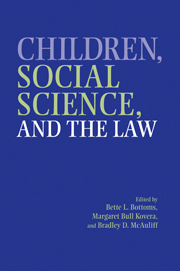Book contents
- Frontmatter
- Contents
- Acknowledgments
- Contributors
- 1 Children, Social Science, and the Law: An Introduction to the Issues
- PART I CHILDREN'S RIGHTS, THEIR CAPABILITIES, AND SOCIETY'S RESPONSIBILITIES TO CHILDREN
- PART II CHILDREN AND FAMILY CHANGE
- PART III JUVENILE AGGRESSION AND JUVENILE JUSTICE
- PART IV CHILDREN AS VICTIMS AND WITNESSES
- 12 The Effects of Community Violence on Children and Adolescents: Intervention and Social Policy
- 13 Preventing Child Abuse and Neglect
- 14 Children's Eyewitness Memory: True Disclosures and False Reports
- 15 Expert Testimony on the Suggestibility of Children: Does It Fit?
- 16 The Status of Evidentiary and Procedural Innovations in Child Abuse Proceedings
- PART V CONCLUSIONS AND FUTURE DIRECTIONS
- Author Index
- Case Index
- Subject Index
- References
15 - Expert Testimony on the Suggestibility of Children: Does It Fit?
Published online by Cambridge University Press: 24 July 2009
- Frontmatter
- Contents
- Acknowledgments
- Contributors
- 1 Children, Social Science, and the Law: An Introduction to the Issues
- PART I CHILDREN'S RIGHTS, THEIR CAPABILITIES, AND SOCIETY'S RESPONSIBILITIES TO CHILDREN
- PART II CHILDREN AND FAMILY CHANGE
- PART III JUVENILE AGGRESSION AND JUVENILE JUSTICE
- PART IV CHILDREN AS VICTIMS AND WITNESSES
- 12 The Effects of Community Violence on Children and Adolescents: Intervention and Social Policy
- 13 Preventing Child Abuse and Neglect
- 14 Children's Eyewitness Memory: True Disclosures and False Reports
- 15 Expert Testimony on the Suggestibility of Children: Does It Fit?
- 16 The Status of Evidentiary and Procedural Innovations in Child Abuse Proceedings
- PART V CONCLUSIONS AND FUTURE DIRECTIONS
- Author Index
- Case Index
- Subject Index
- References
Summary
State v. Sloan (1995 [Mo. Ct. App.]) was a criminal case of child sexual abuse. A.D., the 6-year-old alleged victim, was dropped off on Friday by her mother at her grandmother's house, where the child's aunt Evelyn and the defendant also resided. Two days later, on Sunday, the child's aunt Anita phoned the child's mother and told her that something was wrong. A.D. then told her mother that the defendant had sexually assaulted her the day before. The mother called the child abuse hot line. On Thursday, 5 days after the alleged abuse, a social worker and a police detective interviewed the child at her school. A.D. reported that her aunt Evelyn had allowed her to get into bed with the defendant and had then left the house. She stated that defendant had “placed his finger in her punkie,” that she had touched his “wiener,” and that defendant “had placed her on his wiener.” Approximately 3 weeks later, the police detective reinterviewed the child, and she gave a similar report. The child testified at the trial, and her testimony was consistent with the testimony of her mother, the social worker, and the detective. The testimony of the child's aunt Evelyn and her grandmother (who both testified for the defense) as to the events subsequent to the alleged abuse was consistent with the child's.
The defendant was convicted, but the conviction was overturned on appeal.
- Type
- Chapter
- Information
- Children, Social Science, and the Law , pp. 378 - 411Publisher: Cambridge University PressPrint publication year: 2002
References
- 26
- Cited by



